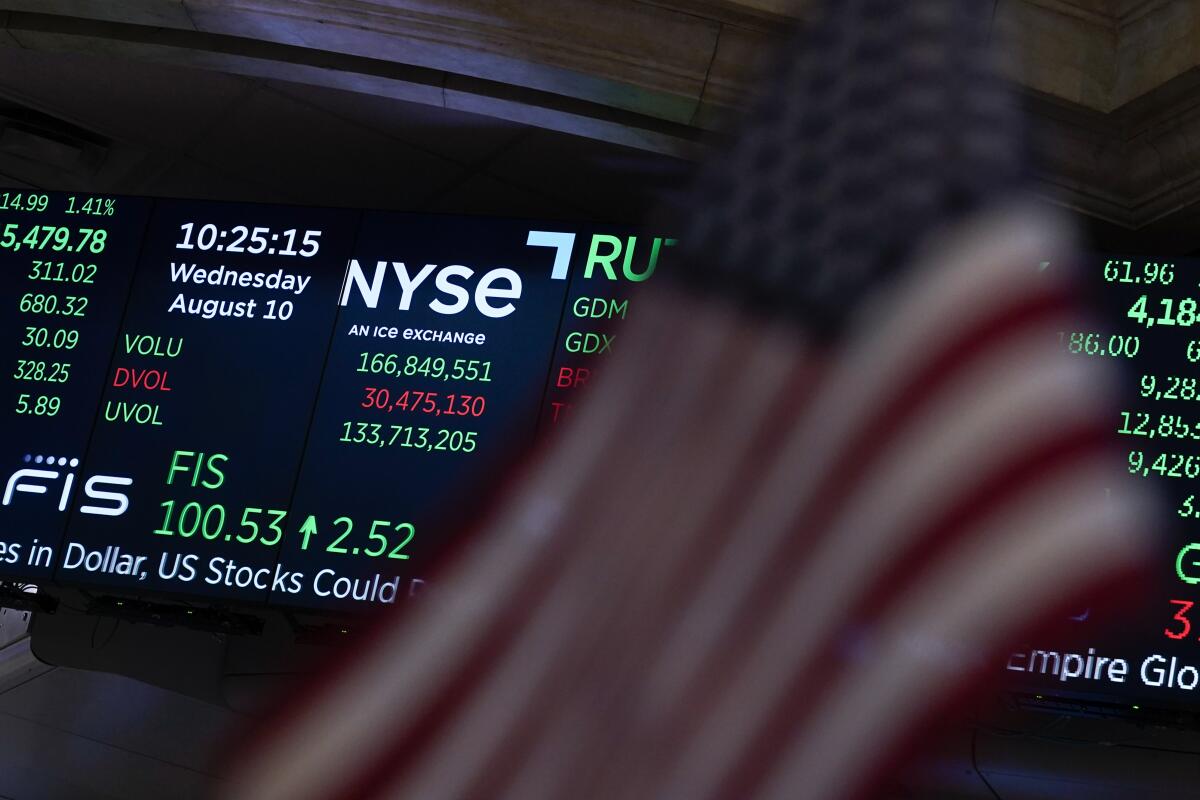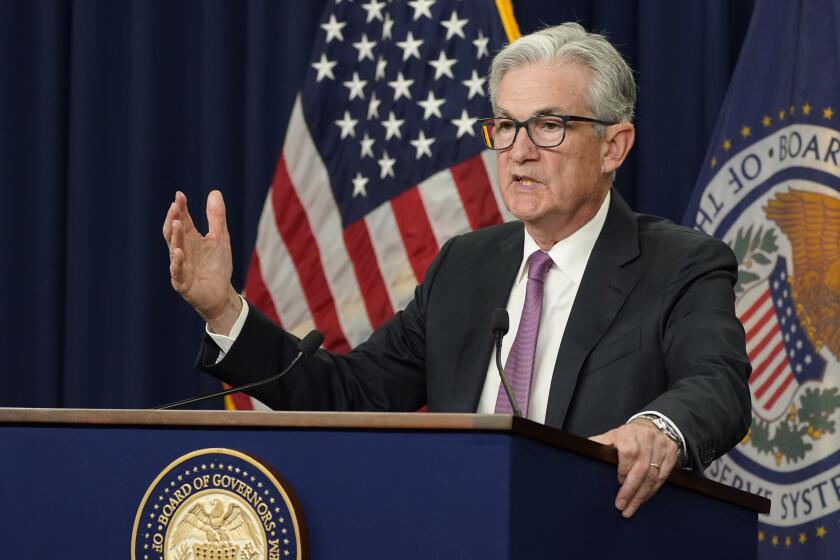Stocks sink after Fed dashes hopes for easing up on rates

- Share via
Stocks are ending sharply lower after the head of the Federal Reserve dashed Wall Street’s hopes that it may soon ease up on rate hikes in its effort to tame inflation.
The S&P 500 lost 3.4% Friday, its biggest drop in two months, after Jerome Powell said the Fed will likely need to keep interest rates high enough to slow the economy for some time in order to beat back the high inflation sweeping the country.
Tech stocks led the way lower, pulling the Nasdaq composite down even more. Higher rates help corral inflation, but they also hurt asset prices.
The Dow Jones industrial average was down 954 points, or 2.9%, at 32,338, as of 3:45 p.m. Eastern time, and the Nasdaq composite was 3.8% lower.
Investors initially struggled to make out the meaning of Powell’s highly anticipated speech. Stocks fell at first, then erased nearly all their losses, and then turned decisively lower with all but six of the companies in the S&P 500 in the red.
“He focused more on the Fed’s goals rather than the path,” said Jeffrey Kleintop, chief global investment strategist at Charles Schwab. “That left the market with less to grab onto in terms of the future path for policy.”
Powell’s speech followed up on several other Fed officials, who have recently pushed back on speculation the Fed may ease up on its interest-rate hikes. The increases help corral inflation, but they also hurt the economy and investment prices.
Powell acknowledged the increases will hurt U.S. households and businesses, in perhaps an unspoken nod to the potential for a recession. But he also said the pain would be far greater if inflation were allowed to fester and that “we must keep at it until the job is done.”
Federal Reserve Chair Jerome H. Powell says more large interest rate hikes are likely in coming months to combat inflation.
He was speaking at an annual economic symposium in Jackson Hole, Wyo., which has been the setting for market-moving Fed speeches in the past.
“He basically said there will be pain and that they won’t stop and can’t stop hiking until inflation moves a lot lower,” said Brian Jacobsen, senior investment strategist at Allspring Global Investments. “It was a mercifully short speech and to the point. Powell didn’t really break new ground, which is good since Jackson Hole isn’t a policy meeting.”
Expectations had built through the week that Powell would try to bat down recent talk about a “pivot” by the Fed. Such speculation had helped stocks surge through the summer. Some investors were even saying the Fed could cut interest rates later in 2023, as pressures on the economy mount and the nation’s high inflation hopefully recedes.
But Powell’s speech made clear the Fed will accept weaker growth for a while for the sake of getting inflation under control, analysts said.
“Powell reiterated that the Fed is worried about rising prices, and getting inflation under control is emphatically job No. 1,” said Jeff Klingelhofer, co-head of investments at Thornburg Investment Management.
Perhaps giving some hope to investors, some analysts said Powell seemed to indicate expectations for future inflation aren’t taking off. If that were to happen, it could cause a self-perpetuating cycle that worsens inflation.
The government on Thursday updated its estimate of the U.S. economy’s performance in the April-June quarter and confirmed what it had reported last month: That the economy shrank for two straight quarters.
A report on Friday said U.S. consumers are expecting 2.9% annual inflation over the long run, which is at the lower end of the 2.9% to 3.1% range seen in the University of Michigan’s survey over the last year.
For now, the debate on Wall Street is whether the Fed will raise short-term rates by either half a percentage point next month, double the usual margin, or by three-quarters of a point. The Fed’s last two hikes have been by 0.75 point, and a slight majority of bets on Wall Street are favoring a third such increase in September, according to CME Group.
A report Friday morning showed that the Fed’s preferred gauge of inflation decelerated last month and wasn’t as bad as many economists expected. It’s a potentially encouraging signal, which may embolden more of Wall Street to say that the worst of inflation has already passed or will soon.
Other data showed that incomes for Americans rose less last month than expected, while consumer spending growth slowed.
Following the reports and Powell’s comments, the two-year Treasury yield rose to 3.40% from 3.37% late Thursday. It tends to track expectations for Fed action.
Some bosses consider telework as a benefit. Many workers don’t see it that way but are willing to accept a lower salary, up to a point.
The 10-year Treasury yield, which follows expectations for longer-term economic growth and inflation, fell to 3.01% from 3.03%.
The Fed has already hiked its key overnight interest rate four times this year in hopes of slowing the worst inflation in decades. The hikes have already hurt the housing industry, where more expensive mortgage rates have slowed activity. But the job market has remained strong, helping to prop up the economy.
In the stock market, Ulta Beauty was among the few in the S&P 500 to rise. It gained 0.6% after the retailer reported stronger profit for the latest quarter than expected. Perhaps more importantly, it raised its forecast for revenue and earnings for the full fiscal year. Other retailers have been cutting their forecasts as high inflation squeezes their customers, particularly lower-income ones.
More to Read
Inside the business of entertainment
The Wide Shot brings you news, analysis and insights on everything from streaming wars to production — and what it all means for the future.
You may occasionally receive promotional content from the Los Angeles Times.













